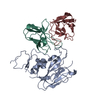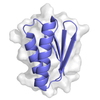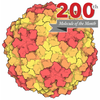+ データを開く
データを開く
- 基本情報
基本情報
| 登録情報 |  | |||||||||
|---|---|---|---|---|---|---|---|---|---|---|
| タイトル | Structure of UT14 Fab in complex with the head domain of H3 (A/Singapore/INFIMH-16-0019/2016) | |||||||||
 マップデータ マップデータ | ||||||||||
 試料 試料 |
| |||||||||
 キーワード キーワード | Complex / viral protein / immune system / Influenza / Hemagglutinin | |||||||||
| 機能・相同性 |  機能・相同性情報 機能・相同性情報clathrin-dependent endocytosis of virus by host cell / host cell surface receptor binding / fusion of virus membrane with host plasma membrane / fusion of virus membrane with host endosome membrane / viral envelope / virion attachment to host cell / host cell plasma membrane / membrane 類似検索 - 分子機能 | |||||||||
| 生物種 |  Homo sapiens (ヒト) / Homo sapiens (ヒト) /   Influenza A virus (A型インフルエンザウイルス) Influenza A virus (A型インフルエンザウイルス) | |||||||||
| 手法 | 単粒子再構成法 / クライオ電子顕微鏡法 / 解像度: 3.8 Å | |||||||||
 データ登録者 データ登録者 | Park J / Georgiou G | |||||||||
| 資金援助 |  米国, 1件 米国, 1件
| |||||||||
 引用 引用 |  ジャーナル: Lancet Microbe / 年: 2025 ジャーナル: Lancet Microbe / 年: 2025タイトル: Molecular features of the serological IgG repertoire elicited by egg-based, cell-based, or recombinant haemagglutinin-based seasonal influenza vaccines: a comparative, prospective, ...タイトル: Molecular features of the serological IgG repertoire elicited by egg-based, cell-based, or recombinant haemagglutinin-based seasonal influenza vaccines: a comparative, prospective, observational cohort study. 著者: Juyeon Park / Foteini Bartzoka / Troy von Beck / Zhu-Nan Li / Margarita Mishina / Luke S Hebert / Jessica Kain / Feng Liu / Suresh Sharma / Weiping Cao / Devon J Eddins / Amrita Kumar / Jin ...著者: Juyeon Park / Foteini Bartzoka / Troy von Beck / Zhu-Nan Li / Margarita Mishina / Luke S Hebert / Jessica Kain / Feng Liu / Suresh Sharma / Weiping Cao / Devon J Eddins / Amrita Kumar / Jin Eyun Kim / Justin S Lee / Yuanyuan Wang / Evan A Schwartz / Axel F Brilot / Ed Satterwhite / Dalton M Towers / Eric McKnight / Jan Pohl / Mark G Thompson / Manjusha Gaglani / Fatimah S Dawood / Allison L Naleway / James Stevens / Richard B Kennedy / Joshy Jacob / Jason J Lavinder / Min Z Levine / Shivaprakash Gangappa / Gregory C Ippolito / Suryaprakash Sambhara / George Georgiou /  要旨: BACKGROUND: Egg-based inactivated quadrivalent seasonal influenza vaccine (eIIV4), cell culture-based inactivated quadrivalent seasonal influenza vaccine (ccIIV4), and recombinant haemagglutinin (HA) ...BACKGROUND: Egg-based inactivated quadrivalent seasonal influenza vaccine (eIIV4), cell culture-based inactivated quadrivalent seasonal influenza vaccine (ccIIV4), and recombinant haemagglutinin (HA)-based quadrivalent seasonal influenza vaccine (RIV4) have been licensed for use in the USA. In this study, we used antigen-specific serum proteomics analysis to assess how the molecular composition and qualities of the serological antibody repertoires differ after seasonal influenza immunisation by each of the three vaccines and how different vaccination platforms affect the HA binding affinity and breadth of the serum antibodies that comprise the polyclonal response. 手法: In this comparative, prospective, observational cohort study, we included female US health-care personnel (mean age 47·6 years [SD 8]) who received a single dose of RIV4, eIIV4, or ccIIV4 ...手法: In this comparative, prospective, observational cohort study, we included female US health-care personnel (mean age 47·6 years [SD 8]) who received a single dose of RIV4, eIIV4, or ccIIV4 during the 2018-19 influenza season at Baylor Scott & White Health (Temple, TX, USA). Eligible individuals were selected based on comparable day 28 serum microneutralisation titres and similar vaccination history. Laboratory investigators were blinded to assignment until testing was completed. The preplanned exploratory endpoints were assessed by deconvoluting the serological repertoire specific to A/Singapore/INFIMH-16-0019/2016 (H3N2) HA before (day 0) and after (day 28) immunisation using bottom-up liquid chromatography-mass spectrometry proteomics (referred to as Ig-Seq) and natively paired variable heavy chain-variable light chain high-throughput B-cell receptor sequencing (referred to as BCR-Seq). Features of the antigen-specific serological repertoire at day 0 and day 28 for the three vaccine groups were compared. Antibodies identified with high confidence in sera were recombinantly expressed and characterised in depth to determine the binding affinity and breadth to time-ordered H3 HA proteins. FINDINGS: During September and October of the 2018-19 influenza season, 15 individuals were recruited and assigned to receive RIV4 (n=5), eIIV4 (n=5), or ccIIV4 (n=5). For all three cohorts, the ...FINDINGS: During September and October of the 2018-19 influenza season, 15 individuals were recruited and assigned to receive RIV4 (n=5), eIIV4 (n=5), or ccIIV4 (n=5). For all three cohorts, the serum antibody repertoire was dominated by back-boosted antibody lineages (median 98% [95% CI 88-99]) that were present in the serum before vaccination. Although vaccine platform-dependent differences were not evident in the repertoire diversity, somatic hypermutation, or heavy chain complementarity determining region 3 biochemical features, antibodies boosted by RIV4 showed substantially higher binding affinity to the vaccine H3/HA (median half-maximal effective concentration [EC50] to A/Singapore/INFIMH-16-0019/2016 HA: 0·037 μg/mL [95% CI 0·012-0·12] for RIV4; 4·43 μg/mL [0·030-100·0] for eIIV4; and 18·50 μg/mL [0·99-100·0] μg/mL for ccIIV4) and also the HAs from contemporary H3N2 strains than did those elicited by eIIV4 or ccIIV4 (median EC50 to A/Texas/50/2012 HA: 0·037 μg/mL [0·017-0·32] for RIV4; 1·10 μg/mL [0·045-100] for eIIV4; and 12·6 μg/mL [1·8-100] for ccIIV4). Comparison of B-cell receptor sequencing repertoires on day 7 showed that eIIV4 increased the median frequency of canonical egg glycan-targeting B cells (0·20% [95% CI 0·067-0·37] for eIIV4; 0·058% [0·050-0·11] for RIV4; and 0·035% [0-0·062] for ccIIV4), whereas RIV4 vaccination decreased the median frequency of B-cell receptors displaying stereotypical features associated with membrane proximal anchor-targeting antibodies (0·062% [95% CI 0-0·084] for RIV4; 0·12% [0·066-0·16] for eIIV4; and 0·18% [0·016-0·20] for ccIIV4). In exploratory analysis, we characterised the structure of a highly abundant monoclonal antibody that binds to both group 1 and 2 HAs and recognises the HA trimer interface, despite its sequence resembling the stereotypical sequence motif found in membrane-proximal anchor binding antibodies. INTERPRETATION: Although all three licensed seasonal influenza vaccines elicit serological antibody repertoires with indistinguishable features shaped by heavy imprinting, the RIV4 vaccine ...INTERPRETATION: Although all three licensed seasonal influenza vaccines elicit serological antibody repertoires with indistinguishable features shaped by heavy imprinting, the RIV4 vaccine selectively boosts higher affinity monoclonal antibodies to contemporary strains and elicits greater serum binding potency and breadth, possibly as a consequence of the multivalent structural features of the HA immunogen in this vaccine formulation. Collectively, our findings show advantages of RIV4 vaccines and more generally highlight the benefits of multivalent HA immunogens in promoting higher affinity serum antibody responses. FUNDING: Centers for Disease Control and Prevention, National Institutes of Health, and Bill & Melinda Gates Foundation. | |||||||||
| 履歴 |
|
- 構造の表示
構造の表示
| 添付画像 |
|---|
- ダウンロードとリンク
ダウンロードとリンク
-EMDBアーカイブ
| マップデータ |  emd_42839.map.gz emd_42839.map.gz | 59.7 MB |  EMDBマップデータ形式 EMDBマップデータ形式 | |
|---|---|---|---|---|
| ヘッダ (付随情報) |  emd-42839-v30.xml emd-42839-v30.xml emd-42839.xml emd-42839.xml | 23.9 KB 23.9 KB | 表示 表示 |  EMDBヘッダ EMDBヘッダ |
| FSC (解像度算出) |  emd_42839_fsc.xml emd_42839_fsc.xml | 8.5 KB | 表示 |  FSCデータファイル FSCデータファイル |
| 画像 |  emd_42839.png emd_42839.png | 33.2 KB | ||
| Filedesc metadata |  emd-42839.cif.gz emd-42839.cif.gz | 7.6 KB | ||
| その他 |  emd_42839_half_map_1.map.gz emd_42839_half_map_1.map.gz emd_42839_half_map_2.map.gz emd_42839_half_map_2.map.gz | 59.5 MB 59.5 MB | ||
| アーカイブディレクトリ |  http://ftp.pdbj.org/pub/emdb/structures/EMD-42839 http://ftp.pdbj.org/pub/emdb/structures/EMD-42839 ftp://ftp.pdbj.org/pub/emdb/structures/EMD-42839 ftp://ftp.pdbj.org/pub/emdb/structures/EMD-42839 | HTTPS FTP |
-検証レポート
| 文書・要旨 |  emd_42839_validation.pdf.gz emd_42839_validation.pdf.gz | 762.5 KB | 表示 |  EMDB検証レポート EMDB検証レポート |
|---|---|---|---|---|
| 文書・詳細版 |  emd_42839_full_validation.pdf.gz emd_42839_full_validation.pdf.gz | 762.3 KB | 表示 | |
| XML形式データ |  emd_42839_validation.xml.gz emd_42839_validation.xml.gz | 15.9 KB | 表示 | |
| CIF形式データ |  emd_42839_validation.cif.gz emd_42839_validation.cif.gz | 20.1 KB | 表示 | |
| アーカイブディレクトリ |  https://ftp.pdbj.org/pub/emdb/validation_reports/EMD-42839 https://ftp.pdbj.org/pub/emdb/validation_reports/EMD-42839 ftp://ftp.pdbj.org/pub/emdb/validation_reports/EMD-42839 ftp://ftp.pdbj.org/pub/emdb/validation_reports/EMD-42839 | HTTPS FTP |
-関連構造データ
| 関連構造データ |  8uzcMC M: このマップから作成された原子モデル C: 同じ文献を引用 ( |
|---|---|
| 類似構造データ | 類似検索 - 機能・相同性  F&H 検索 F&H 検索 |
- リンク
リンク
| EMDBのページ |  EMDB (EBI/PDBe) / EMDB (EBI/PDBe) /  EMDataResource EMDataResource |
|---|---|
| 「今月の分子」の関連する項目 |
- マップ
マップ
| ファイル |  ダウンロード / ファイル: emd_42839.map.gz / 形式: CCP4 / 大きさ: 64 MB / タイプ: IMAGE STORED AS FLOATING POINT NUMBER (4 BYTES) ダウンロード / ファイル: emd_42839.map.gz / 形式: CCP4 / 大きさ: 64 MB / タイプ: IMAGE STORED AS FLOATING POINT NUMBER (4 BYTES) | ||||||||||||||||||||||||||||||||||||
|---|---|---|---|---|---|---|---|---|---|---|---|---|---|---|---|---|---|---|---|---|---|---|---|---|---|---|---|---|---|---|---|---|---|---|---|---|---|
| 投影像・断面図 | 画像のコントロール
画像は Spider により作成 | ||||||||||||||||||||||||||||||||||||
| ボクセルのサイズ | X=Y=Z: 1.0415 Å | ||||||||||||||||||||||||||||||||||||
| 密度 |
| ||||||||||||||||||||||||||||||||||||
| 対称性 | 空間群: 1 | ||||||||||||||||||||||||||||||||||||
| 詳細 | EMDB XML:
|
-添付データ
-ハーフマップ: #2
| ファイル | emd_42839_half_map_1.map | ||||||||||||
|---|---|---|---|---|---|---|---|---|---|---|---|---|---|
| 投影像・断面図 |
| ||||||||||||
| 密度ヒストグラム |
-ハーフマップ: #1
| ファイル | emd_42839_half_map_2.map | ||||||||||||
|---|---|---|---|---|---|---|---|---|---|---|---|---|---|
| 投影像・断面図 |
| ||||||||||||
| 密度ヒストグラム |
- 試料の構成要素
試料の構成要素
-全体 : Structure of UT14 Fab in complex with the head domain of H3 (A/Si...
| 全体 | 名称: Structure of UT14 Fab in complex with the head domain of H3 (A/Singapore/INFIMH-16-0019/2016) |
|---|---|
| 要素 |
|
-超分子 #1: Structure of UT14 Fab in complex with the head domain of H3 (A/Si...
| 超分子 | 名称: Structure of UT14 Fab in complex with the head domain of H3 (A/Singapore/INFIMH-16-0019/2016) タイプ: complex / ID: 1 / 親要素: 0 / 含まれる分子: all |
|---|---|
| 分子量 | 理論値: 113 KDa |
-分子 #1: UT14 Fab heavy chain
| 分子 | 名称: UT14 Fab heavy chain / タイプ: protein_or_peptide / ID: 1 / コピー数: 1 / 光学異性体: LEVO |
|---|---|
| 由来(天然) | 生物種:  Homo sapiens (ヒト) Homo sapiens (ヒト) |
| 分子量 | 理論値: 24.28108 KDa |
| 組換発現 | 生物種:  Homo sapiens (ヒト) Homo sapiens (ヒト) |
| 配列 | 文字列: QVQLVESGGG VVQPGRSLRL SCATSGFTFS SYGIHWVRQA PGKGLGWVAM ISFDGSKTYY ADSVRGRFTI SRDNSKNTLS LQMNSLRTE DTAVYYCAKE RDRDGYNEGI YDYWGQGTLV TVSSASTKGP SVFPLAPSSK STSGGTAALG CLVKDYFPEP V TVSWNSGA ...文字列: QVQLVESGGG VVQPGRSLRL SCATSGFTFS SYGIHWVRQA PGKGLGWVAM ISFDGSKTYY ADSVRGRFTI SRDNSKNTLS LQMNSLRTE DTAVYYCAKE RDRDGYNEGI YDYWGQGTLV TVSSASTKGP SVFPLAPSSK STSGGTAALG CLVKDYFPEP V TVSWNSGA LTSGVHTFPA VLQSSGLYSL SSVVTVPSSS LGTQTYICNV NHKPSNTKVD KKVEPKSCD |
-分子 #2: UT14 Fab light chain
| 分子 | 名称: UT14 Fab light chain / タイプ: protein_or_peptide / ID: 2 / コピー数: 1 / 光学異性体: LEVO |
|---|---|
| 由来(天然) | 生物種:  Homo sapiens (ヒト) Homo sapiens (ヒト) |
| 分子量 | 理論値: 23.687346 KDa |
| 組換発現 | 生物種:  Homo sapiens (ヒト) Homo sapiens (ヒト) |
| 配列 | 文字列: EIVMTQSPAT LSLSPGERAT LSCRASQSAG FYLAWYQQKP GQAPRLLIYD TSNRATGIPA RFSGRGSGTD FTLTINSLEP EDFAVYYCQ QRYNWPITFG QGTRLEIKRT VAAPSVFIFP PSDEQLKSGT ASVVCLLNNF YPREAKVQWK VDNALQSGNS Q ESVTEQDS ...文字列: EIVMTQSPAT LSLSPGERAT LSCRASQSAG FYLAWYQQKP GQAPRLLIYD TSNRATGIPA RFSGRGSGTD FTLTINSLEP EDFAVYYCQ QRYNWPITFG QGTRLEIKRT VAAPSVFIFP PSDEQLKSGT ASVVCLLNNF YPREAKVQWK VDNALQSGNS Q ESVTEQDS KDSTYSLSST LTLSKADYEK HKVYACEVTH QGLSSPVTKS FNRGEC |
-分子 #3: Hemagglutinin
| 分子 | 名称: Hemagglutinin / タイプ: protein_or_peptide / ID: 3 / コピー数: 1 / 光学異性体: LEVO |
|---|---|
| 由来(天然) | 生物種:   Influenza A virus (A型インフルエンザウイルス) Influenza A virus (A型インフルエンザウイルス)株: H3N2 (A/Singapore/INFIMH-16-0019/2016) |
| 分子量 | 理論値: 65.679719 KDa |
| 組換発現 | 生物種:  Homo sapiens (ヒト) Homo sapiens (ヒト) |
| 配列 | 文字列: MKTIIALSYI LCLVFAQKIP GNDNSTATLC LGHHAVPNGT IVKTITNDRI EVTNATELVQ NSSIGEICDS PHQILDGENC TLIDALLGD PQCDGFQNKK WDLFVERSKA YSNCYPYDVP DYASLRSLVA SSGTLEFKNE SFNWTGVTQN GTSSACIRGS S SSFFSRLN ...文字列: MKTIIALSYI LCLVFAQKIP GNDNSTATLC LGHHAVPNGT IVKTITNDRI EVTNATELVQ NSSIGEICDS PHQILDGENC TLIDALLGD PQCDGFQNKK WDLFVERSKA YSNCYPYDVP DYASLRSLVA SSGTLEFKNE SFNWTGVTQN GTSSACIRGS S SSFFSRLN WLTHLNYTYP ALNVTMPNKE QFDKLYIWGV HHPGTDKDQI FLYAQSSGRI TVSTKRSQQA VIPNIGSRPR IR DIPSRIS IYWTIVKPGD ILLINSTGNL IAPRGYFKIR SGKSSIMRSD APIGKCKSEC ITPNGSIPND KPFQNVNRIT YGA CPRYVK HSTLKLATGM RNVPEKQTRG IFGAIAGFIE NGWEGMVDGW YGFRHQNSEG RGQAADLKST QAAIDQINGK LNRL IGKTN EKFHQIEKEF SEVEGRVQDL EKYVEDTKID LWSYNAELLV ALENQHTIDL TDSEMNKLFE KTKKQLRENA EDMGN GCFK IYHKCDNACI ESIRNETYDH NVYRDEALNN RFQIKGVELK SGYKDGSGYI PEAPRDGQAY VRKDGEWVLL STFLGS GLN DIFEAQKIEW HEGSHHHHHH UniProtKB: Hemagglutinin |
-実験情報
-構造解析
| 手法 | クライオ電子顕微鏡法 |
|---|---|
 解析 解析 | 単粒子再構成法 |
| 試料の集合状態 | particle |
- 試料調製
試料調製
| 濃度 | 1 mg/mL | ||||||||||||
|---|---|---|---|---|---|---|---|---|---|---|---|---|---|
| 緩衝液 | pH: 8 構成要素:
詳細: 2 mM Tris pH 8.0, 200 mM NaCl, 0.02% NaN3 | ||||||||||||
| グリッド | モデル: Au-flat 1.2/1.3 / 材質: GOLD / 前処理 - タイプ: PLASMA CLEANING / 前処理 - 時間: 240 sec. 詳細: A total of 3ul of the specimen was applied to Au-flat 1.2/1.3-hole pattern 300 mesh grids (Electron Microscopy Sciences, PA; Cat. AUFT313-50) that had been plasma cleaned in a PELCO easiGlow ...詳細: A total of 3ul of the specimen was applied to Au-flat 1.2/1.3-hole pattern 300 mesh grids (Electron Microscopy Sciences, PA; Cat. AUFT313-50) that had been plasma cleaned in a PELCO easiGlow plasma cleaner (Ted Pella Inc., CA) for 4 min and were plunge-frozen into liquid ethane using Thermo Fisher/FEI Vitrobot Mark IV at 4 celsius under 100% humidity. Excess liquid was blotted for 4-6 sec. | ||||||||||||
| 凍結 | 凍結剤: ETHANE / チャンバー内湿度: 100 % / チャンバー内温度: 277 K / 装置: FEI VITROBOT MARK IV |
- 電子顕微鏡法
電子顕微鏡法
| 顕微鏡 | FEI TITAN KRIOS |
|---|---|
| 特殊光学系 | エネルギーフィルター - 名称: GIF Bioquantum / エネルギーフィルター - スリット幅: 10 eV 詳細: The grids were imaged using a FEI Titan Krios G3 300kV cryo-TEM (Thermo Fisher Scientific, MA) equipped with a K3 direct electron detection camera (Gatan, CA) with a slit width 10eV Gatan ...詳細: The grids were imaged using a FEI Titan Krios G3 300kV cryo-TEM (Thermo Fisher Scientific, MA) equipped with a K3 direct electron detection camera (Gatan, CA) with a slit width 10eV Gatan BioContinuum Imaging Filter. |
| 撮影 | フィルム・検出器のモデル: GATAN K3 (6k x 4k) / 平均電子線量: 80.0 e/Å2 詳細: The calibrated pixel sizes were 0.83A/pixel with a total dose of 80e/A^2. |
| 電子線 | 加速電圧: 300 kV / 電子線源:  FIELD EMISSION GUN FIELD EMISSION GUN |
| 電子光学系 | C2レンズ絞り径: 70.0 µm / 照射モード: FLOOD BEAM / 撮影モード: BRIGHT FIELD / Cs: 2.7 mm / 最大 デフォーカス(公称値): 2.5 µm / 最小 デフォーカス(公称値): 0.9 µm |
| 実験機器 |  モデル: Titan Krios / 画像提供: FEI Company |
 ムービー
ムービー コントローラー
コントローラー










 Z (Sec.)
Z (Sec.) Y (Row.)
Y (Row.) X (Col.)
X (Col.)





































